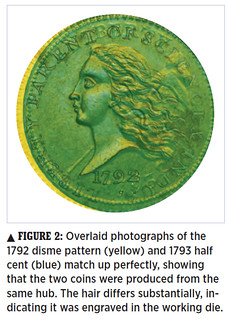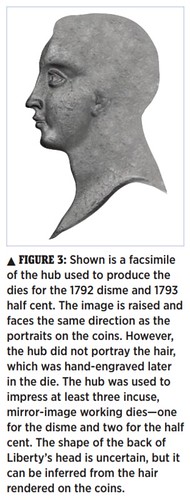
PREV ARTICLE
NEXT ARTICLE
FULL ISSUE
PREV FULL ISSUE
U.S. MINT HUBBING DIES IN 1793
The publication of the August issue of The Numismatist from the American Numismatic Association has shamed me into finally highlighting a great article in the June 2017 issue by Bill Eckberg on the use of hubbing dies in early America. Here's an excerpt.
-Editor
Hubbing Dies in the Earliest days of the United States Mint
Hubbing is the process
of creating multiple
dies that bear the same
elements. A hub is a
raised punch used to
impress a design into a die.
Though the terms
“punch” and “hub”
often are used interchangeably,
for the
purpose of this article
the difference between
them is a matter of
size. A punch is small
and features a single
letter, numeral, leaf or
other ornament; a hub
carries a larger device,
such as a head, wreath
or eagle, or even all
the images that appear
on one side of
a coin.
Hubbing is thought to
have begun in the United States
with the creation of obverse and
reverse dies for some Connecticut state coppers. The first
time the U.S. Mint used a hub
for the main device was believed
to have been in 1793 for
the Liberty Cap cents.
Since at least the late 19th
century, numismatists have remarked
on the artistic similar ities
between the 1792 disme pattern
and the 1793 half cent, suggesting
that they were executed by the same hand, namely Voigt’s.
Recently, I delved into this mystery.
Could the resemblance be
more than coincidental?
The main variance between the
dies (and probably the reason
nobody has noticed their exact
match) is the hair.
My findings show conclusively
that a single hub was used
for both the 1792 disme pattern
and 1793 half cent obverses.
Figure 3 shows how that hub
probably looked. Although the
hair was not defined, the approximate
shape of Liberty’s head can be determined.
The question remains: Why
would Voigt have prepared a
hub for the disme pattern in
1792? We can’t know for sure,
but the simplest explanation is
that he was experimenting.
Voigt must have known that the
hubbing process could produce
a number of nearly identical
dies and simply gave it a try.
Since he had successfully made
and used a hub, I wonder why
he reverted to hand- engraving
the Chain cent obverses. Of
course, I can only speculate, but
perhaps he was concerned that
a larger hub might not be effectual.
How ever, Voigt obviously
didn’t hesitate for long, as he
developed a hub for the Wreath
cent obverse within days of the
Chain cent minting and re-used
the leftover hub from the previous
year’s disme pattern for the
half cents.
In retrospect, Henry Voigt
deserves immense credit. Accepting
a temporary position
as the U.S. Mint’s chief coiner,
he experimented with hubbing
as early as 1792. He truly was a
remarkable and talented man,
without whom the mint might
not have succeeded.
For more information about the American Numismatic Association, see:

|



